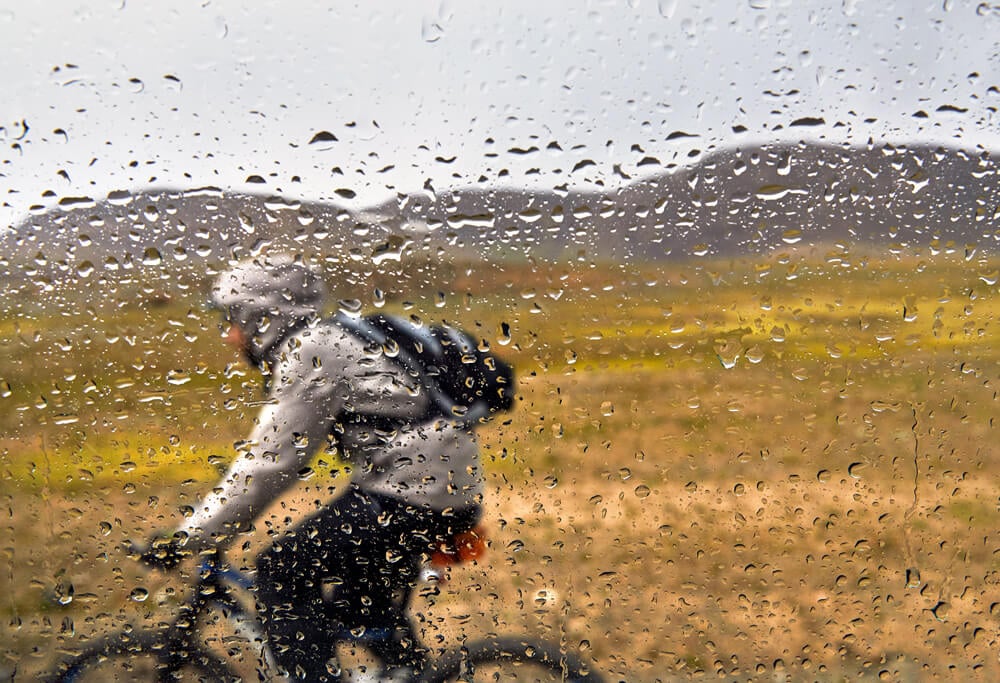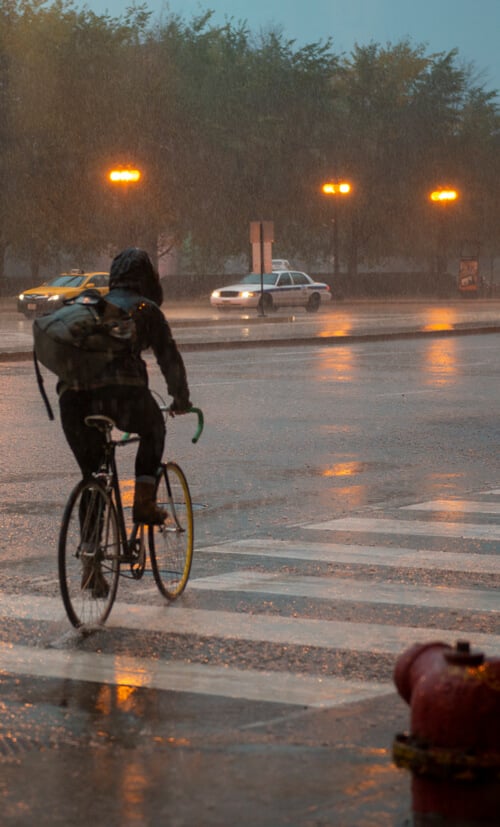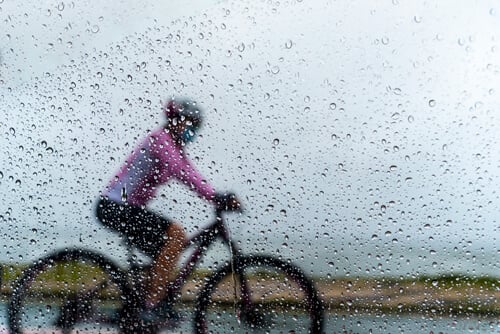Can you ride an electric bike in the rain? Are electric bikes waterproof? Here are some best practices if you want to ride an e-bike in the rain.
Electric Bike in Rain: Are E-bikes Waterproof?
A quality e-bike may be used for daily activities and commuting. As a result, it helps you to travel fast and effortlessly across metropolitan areas. Also, it keeps you in shape and reduces carbon emissions, but can you ride an e-bike in the rain?
In a nutshell, yes, you can use an e-bike safely in the rain. But it’s important to understand that riding in rainy weather may be dangerous. Rain increases the chances of damaging the bike’s integral parts, such as the engine and battery. However, if you go for a water-resistant e-bike, you won’t have to worry about this.

Are E-bikes Waterproof?
Those who feel the need or have a necessity to ride their electric two-wheeled pedal vehicles in the rain must know for sure whether or not their bikes are waterproof. There is one thing you must be aware of, and it is the fact that no electric bicycle is completely waterproof.
Although many electric bicycles have some degree of water resistance, there is no such thing as complete waterproofness.
So, what is the difference between “proof” and “resistance”? Think of electronic devices that you most probably have. For instance, your smartphone. Even in heavy rain, you can take it out of your pocket to call somebody. It will get wet, but apart from that, nothing extra bad will happen; however, if you put it inside a bowl of water, high chance that it will short circuit and die.
On the other hand, your smartwatch or fitness tracker can be easily used underwater, for instance, when you swim in a pool. The latter case shows us a waterproof attribute as no water can go in or out of the device. The former is water resistance. It suggests that the item is meant to keep water out, but there is no assurance that it will.
The water-resistance feature is an essential part of the vast majority of electric bikes. This implies that they can outlive being wet. E-bikes that are submerged in a pool or become wet from heavy rain are at risk of damage to their crucial electrical elements.
You should treat an electric bicycle the same way a computer or a mobile phone since you don’t want to risk damaging it by leaving it out in the rain for a prolonged period. In an emergency, you could ride an electric bike in the rain; nevertheless, you should make every effort to remove it from the rain as soon as possible to protect its delicate components.
Can E-bike’s Electronics Get Wet?
All of the components may become wet, just as in a conventional bicycle, but they must be dried correctly. Electric bikes, on the other hand, unquestionably include electric components. The heart of the vehicle, or simply the battery, and the drivetrain are the most critical items to keep dry. You run the risk of damaging your bike or possibly receiving an electric shock if any of these components becomes wet.
If you have to drive through a light shower, you won’t have any problems. To avoid damaging your battery or engine, you should dismount and seek cover if it begins to rain heavily enough that the side of your bike is submerged. Pedal or push the bike instead of using the engine and attempt to keep it as dry as possible.
Your e-bike is more likely to be destroyed if its motor is running while it’s raining. When a motor, for example, becomes wet but isn’t running, it might be dried out and made to operate again. So, if you’re unsure, pat it dry and give it as much time as you can.

Can I Ride My E-bike in the Rain? Check the IP Rating of Your E-bike
As it comes from all of the aforementioned info, the answer to the question “Can I ride my electric bike in the rain?” is quite straightforward: yes, you can. Most e-bikes are built to withstand rainy weather, so you won’t have any problems if you get rained on. Some of the best manufacturers of e-bikes make sure that water cannot get into critical components like the engine and battery. The robust casings of these components are meant to keep out anything that may clog or damage the device, including dirt, dust, and water. The ingress protection rating, often known as the IP rating, is the standard metric used to grade electrical systems for how well they are protected against water and dust. In the same way that it is used for many other items, an IP rating is a two-number categorization that shows you how any product resists water and/or dust. With an IP rating of 5 or 6, most e-bike batteries are protected against dust ingress and water immersion. Most eBike motors and batteries are either partially or entirely dust-proof, according to the IP rating standard. Your engine won’t be affected by buildup unless you leave it in a garage for a long time. For example, goods branded “IP56” have a level 5 certification for dust and debris resistance and a level 6 rating for water resistance. For the most part, electric bikes are water-resistant up to the point where they are being sprayed directly with a high-pressure water hose. Rain should be no problem for your electric bicycle. However, what you should avoid is getting your e-bike heavily submerged into the water either by going through a big puddle or leaving it in a garage or shed during a flood. Also, keep in mind that using a high-pressure water stream (such as that used to clean cars) to wash your electric bike is a no-go since this may damage seals and components.Electric Bikes in the Rain: Some Best Practices
Taking your electric bicycle for a rain ride is quite safe, and you don’t have to feel uneasy about continuing to do so as long as you follow appropriate safety measures. If you still want to ride even when conditions are less than perfect, consider the following recommended practices.
Buy an e-bike that’s built for your climate
This piece of advice is great for those who still haven’t bought an e-bike. As everyone knows, the climate zone plays a crucial role in defining the weather. Therefore, it is better to choose an e-bike taking into consideration the maximum frequency and amount of rain for your place of residence. With these data, you will be able to find the corresponding IP protection level that will be sufficient to secure your e-bike from getting water/dust damaged. However, if you don’t want to check up on all the climate details, be sure to choose an e-bike with the highest IP level on your market. This guarantees that your e-bike will be able to withstand a fair amount of rain.
Take precautions
When riding an electric bike in the rain, you’ll want to check that it has the proper rain gear installed. This entails having good-quality tires, matching fenders, and functioning brakes. If you wish to be more visible to other drivers, try wearing luminous clothing or installing lights on your vehicle.
Lights
Riding an eBike in rain or at night might be a terrifying experience. As long as your bike is properly equipped, you won’t have to worry about getting in the way or causing a problem.
A headlamp is essential for a safe e-bike ride. Making it easy for other people to notice and avoid you increases your visibility and safety. You will also be able to better notice approaching traffic, pedestrians, and road signs thanks to a headlight.
Mind the pressure
Another good thing to do to make your electric bike rain ride a bit more pleasant is to adjust the pressure in your tires. The basic bike ride on a non-wet new road requires 100 PSI. However, if the surface is wet, is it better to lower the pressure to 90 PSI. This small 10 PSI reduction ensures proper traction under slippery or rainy conditions. By reducing the tire pressure, the tire will be able to make more touch with the road than normal. Your e-bike will have a stronger grip on the street, thus reducing the chance of tumbling over and hurting yourself.
Use proper clothing
One more vital point to consider is your clothing. Warmth and dryness are essential for a comfortable trip. Even if it’s simply raining and the temperature isn’t too cold, you may be able to get by with a rain jacket. Increasing the speed, distance, and difficulty of your rides? It’s important to dress appropriately.
A layering approach to your clothing brings essential benefits as it enables you to add and remove clothes depending on the weather. Cotton, which loses its ability to insulate when wet, should be avoided. Consider wool as an alternative since it is more water resistant and, hence, safer.
Avoid puddles and debris
In heavy downpours, gasoline and oil typically float to the top. Even ordinary asphalt may become a little more unpredictable with this addition. Keep an eye out for slick locations to prevent tripping and falling off your e-bike.
Road lines should be avoided at all costs. When it rains, the road surfaces typically turn slick. Avoid using metal covers and grates since they are as slippery as ice. In addition, mind the debris on the road. Falling leaves may be just as deadly as oils on the street in wet weather.
Avoid heavy rain
We’ve spoken about the dangers of riding electric bikes in the rain and the dangers of keeping them outside in the weather.
Although e-bikes are water-resistant, it is preferable to keep the e-bike indoors while it is pouring outside. More rain may degrade waterproof seals, leading to leakage in the future. If keeping the e-bike inside isn’t an option, you may want to look into getting a waterproof bike cover.
It doesn’t matter whether it’s not pouring outside; we still advocate keeping e-bikes inside. While it’s hot during the day and chilly at night, being outside is a risky proposition because of these extremes. Summers are blisteringly hot, while winters are bone-chillingly cold.
Watertight gaskets and silicone seals may be affected by environmental factors such as direct sunlight exposure. This is why it’s better to keep it inside. In addition, your garage is a less probable location for theft than your front yard.
Dry the battery after driving
It is important to treat your electric bicycle with the same degree of care as you would any other electric gadget. When your phone becomes wet, you need to make sure that it is completely dry before using it again. If you do the same with your electric bike, it will be able to carry you safely through mile after mile of wet weather as long as the seals do not get damaged. If there is a chance that your bicycle may get submerged, you should immediately switch off all electrical components and wait until everything has dried out before trying to turn it back on.
If you must leave your e-bike out in the open, protect it with a watertight covering and try to keep it within an enclosed space if at all feasible, such as a garage or a shed. Models that are portable and collapsible may be carried inside your house or flat.
Wipe down the bike
Keep your bike from drying out on its own after you’ve finished a ride. To remove as much moisture as possible from your bike, use a clean towel to wipe it off. This easy action will maintain your bike in better shape and improve its lifespan.
Conclusion
You can bike in the rain if you take the appropriate measures. Road fans and cyclists alike might benefit from a rainy bike ride. Taking your e-bike out for a ride in the rain may also strengthen your bond and help you appreciate your time with it even more.
